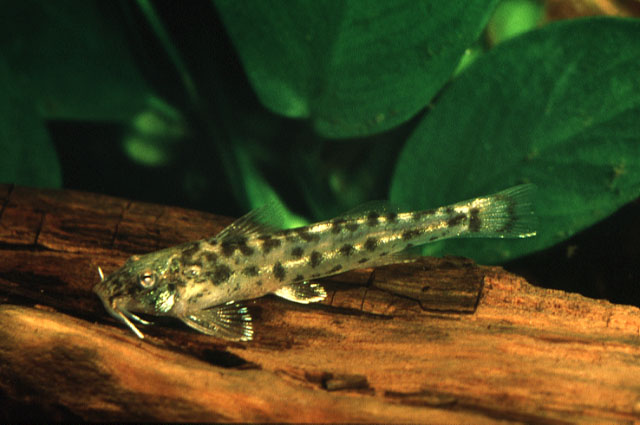| Amphiliidae (Loach catfishes), subfamily: Leptoglaninae |
| 3.79 cm SL (male/unsexed) |
|
demersal; freshwater; dH range: 20 |
| Africa: Lake Victoria, Rufiji and Lake Rukwa systems (Ref. 78218), questionably in Tana River in Kenya (Ref. 52331). Also in Okavango, Zambezi, Pungwe, Buzi, Save systems as well as in the Lake Malawi catchment (Ref. 7248). Presence in the Congo basin questionable (Ref. 51287, 58032, 78218). As it currently stands, this species probably represents a complex of several different species (Ref. 7248). |
|
Dorsal spines (total): 2-2; Dorsal soft rays (total): 5-6; Anal spines: 0-0; Anal soft rays: 11-13; Vertebrae: 35-38. Diagnosis: This species differs from Zaireichthys lacustris and Z. maravensis in possessing a premaxillary tooth patch that is less than 40% of the mouth width; it has shorter barbels than Z. wamiensis, maxillary barbel 0.9-1.3 in head length vs. 0.7-0.9; and it is distinguished from Z. compactus by higher number of branched pectoral-fin rays, 7 vs. 6 (Ref. 86935).
Description: Lateral line moderate, ending over middle or anterior part of anal fin base (Ref. 86935). Head broad and depressed; snout blunt; eye moderate; mouth narrow; barbels relatively short (Ref. 86935). Dorsal fin II,5-6; caudal fin slightly emarginate, with the lower lobe a little longer than the upper, the upper and lower lobes each with 7 or 8 branched rays; anal fin with 11-13 rays, the first 3-4 simple; pectoral fins with 7 branched rays (Ref. 86935). Premaxillary tooth patch narrow, less than 40% of mouth width, sub-rectangular; humeral process of cleithrum extending to between level of end of supraoccipital process and base of dorsal fin; branchiostegal rays 6-7 (Ref. 86935).
Colouration: Preserved: generally yellowish brown with a series of about nine faint dark blotches along centre of flank and traces of additional series above and below (Ref. 86935). |
| Inhabits fairly shallow water (Ref. 13337). Occurs over sand, usually buried with just the eyes protruding. Feeds on minute organisms. Eggs few (12-16) and large (3-5 mm diameter) suggesting possible parental care (Ref. 7248). |
|
Data deficient (DD); Date assessed: 29 February 2016 Ref. (130435)
|
| harmless |
Source and more info: www.fishbase.org. For personal, classroom, and other internal use only. Not for publication.

